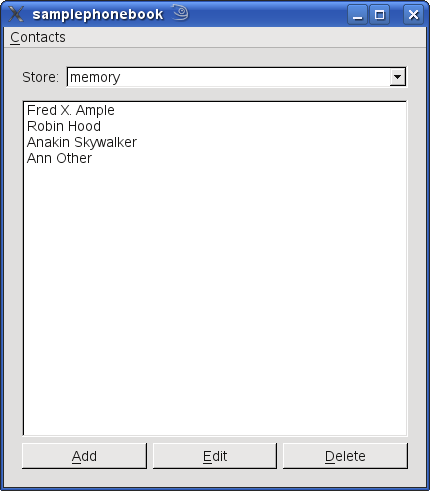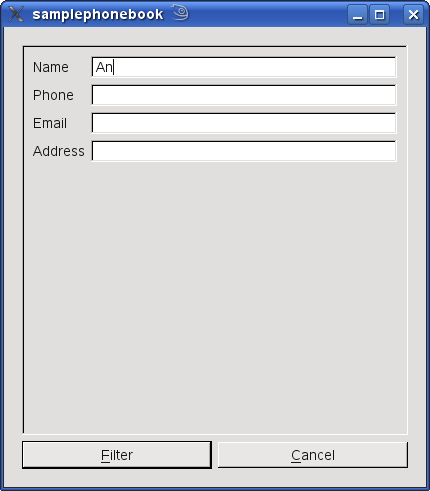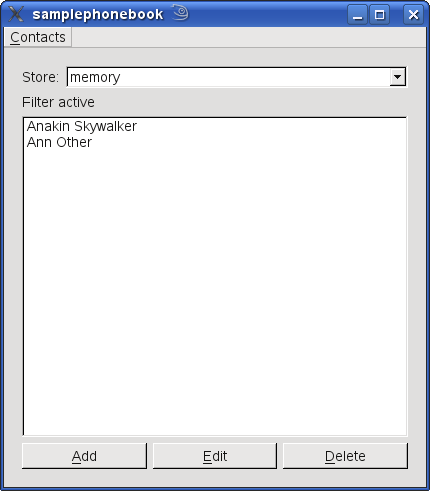Sample Phonebook Example
Files:
- samplephonebook/contacteditor.cpp
- samplephonebook/contacteditor.h
- samplephonebook/contactlistpage.cpp
- samplephonebook/contactlistpage.h
- samplephonebook/filterpage.cpp
- samplephonebook/filterpage.h
- samplephonebook/phonebook.cpp
- samplephonebook/phonebook.h
- samplephonebook/main.cpp
- samplephonebook/samplephonebook.pro
Phone Book
This example shows how to write a simple phonebook with the Contacts API.
Motivation
This application was written to provide an example to developers of how to use the QtContacts and QtVersit APIs.
It provides an example of how to use the QtMobility libraries to:
- select a backend for persistent storage
- list the stored contacts
- add contacts
- edit contacts
- use filters to find contacts matching certain criteria
- import and export contact lists as vCards® *
[*] vCard is a registered trademark of the Internet Mail Consortium
Use Case
Most people have a need to store information (such as addresses, telephone numbers and email addresses) of people that they know. This sample application provides a simple phone book that allows users to store certain pieces of information about their contacts, and save them to the contacts database of their device.
Interface
The application is designed to work on desktop and mobile platforms with minimal differences in code between the platforms. The interface is organized into a paged view, showing the Contact List by default. Contacts can be added, edited or deleted using the buttons at the bottom of the contact list. To search for a contact in the list, a filter can be applied using the Apply Filter item in the Contacts menu.
Here we see the Contact List with some names added.

When adding a new contact a new page is shown, with a Set Picture button to import an image. It is a good idea to use smaller images if you intend to export the contacts to a file later.

From the main menu, Contacts, you can select Apply Filter. This will display a new page which enables the user to specify filter criteria. In the screenshot below, we are selecting based on the first two characters of the Name,

which gives us a subset of the list of contacts.

To reset this, just select Clear Filter from the Contacts menu.
The contact list can also be imported and exported to the vCard format through the Import Contacts and Export Contacts items in the Contacts menu. This functionality can be used to populate the list from another device or application.
Known Issues
The example is not intended to be feature complete. Only a very limited subset of detail types are supported by the application. It exercises only a very small portion of the Qt Contacts API.
In particular:
- The example only exercises the synchronous API of QtContacts. For most real applications, the asynchronous API is the preferred interface to use as it does not block the GUI while a query is made to the contacts backend.
- Detail subtypes and contexts are not supported by the interface.
- Duplicate contacts are not filtered out - importing the same contact twice results in two identical contacts appearing in the list. In a real application, more complex synchronization code may be required.
- Contact groups are not supported. The QtContacts API supports two methods of grouping contacts. One way is to use contacts of type TypeGroup, along with the HasMember QContactRelationship. The other way is to use the QContactTag detail by giving related contacts the same tag. A real application may support grouping via one or both of these methods.
This application has the following known issues on Harmattan:
- You cannot edit contacts because tapping QLineEdit widget does not open the virtual keyboard. See QTBUG-23144
- You cannot set a thumbnail image for contacts. See QTMOBILITY-1992